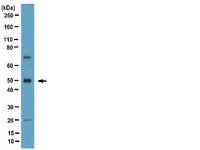06-1066 Sigma-AldrichAnti-IRF-3 Antibody
Use Anti-IRF-3 Antibody (Rabbit Polyclonal Antibody) validated in WB to detect IRF-3 also known as interferon regulatory factor 3.
More>> Use Anti-IRF-3 Antibody (Rabbit Polyclonal Antibody) validated in WB to detect IRF-3 also known as interferon regulatory factor 3. Less<<Prodotti consigliati
Panoramica
| Replacement Information | |
|---|---|
| Replacement Information | MABF21 is the recommended replacement for Discontinued catalog number 06-1066 |
Tabella delle specifiche principali
| Species Reactivity | Key Applications | Host | Format | Antibody Type |
|---|---|---|---|---|
| H | WB | Rb | Unpurified | Polyclonal Antibody |
| References |
|---|
| Product Information | |
|---|---|
| Format | Unpurified |
| Control |
|
| Presentation | Rabbit polyclonal serum with 0.05% sodium azide. |
| Applications | |
|---|---|
| Application | Use Anti-IRF-3 Antibody (Rabbit Polyclonal Antibody) validated in WB to detect IRF-3 also known as interferon regulatory factor 3. |
| Key Applications |
|
| Physicochemical Information |
|---|
| Dimensions |
|---|
| Materials Information |
|---|
| Toxicological Information |
|---|
| Safety Information according to GHS |
|---|
| Safety Information |
|---|
| Packaging Information | |
|---|---|
| Material Size | 100 µL |
| Transport Information |
|---|
| Supplemental Information |
|---|
| Specifications |
|---|
| Global Trade Item Number | |
|---|---|
| Numero di catalogo | GTIN |
| 06-1066 | 04053252274602 |
Documentation
Anti-IRF-3 Antibody Certificati d'Analisi
| Titolo | Numero di lotto |
|---|---|
| Anti-IRF-3 - NRG1633606 | NRG1633606 |







